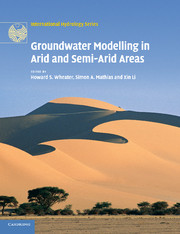Book contents
- Frontmatter
- Contents
- Contributors
- Preface
- Acknowledgements
- 1 Groundwater modelling in arid and semi-arid areas: an introduction
- 2 Hydrological processes, groundwater recharge and surface-water/groundwater interactions in arid and semi-arid areas
- 3 Conceptual models for recharge sequences in arid and semi-arid regions using isotopic and geochemical methods
- 4 Groundwater flow and transport
- 5 Performing unbiased groundwater modelling: application of the theory of regionalised variables
- 6 Groundwater vulnerability and protection
- 7 Variable density groundwater flow: from modelling to applications
- 8 Sustainable water management in arid and semi-arid regions
- Index
- Plate section
Preface
Published online by Cambridge University Press: 06 December 2010
- Frontmatter
- Contents
- Contributors
- Preface
- Acknowledgements
- 1 Groundwater modelling in arid and semi-arid areas: an introduction
- 2 Hydrological processes, groundwater recharge and surface-water/groundwater interactions in arid and semi-arid areas
- 3 Conceptual models for recharge sequences in arid and semi-arid regions using isotopic and geochemical methods
- 4 Groundwater flow and transport
- 5 Performing unbiased groundwater modelling: application of the theory of regionalised variables
- 6 Groundwater vulnerability and protection
- 7 Variable density groundwater flow: from modelling to applications
- 8 Sustainable water management in arid and semi-arid regions
- Index
- Plate section
Summary
Arid and semi-arid regions present special challenges for water management. They are, by definition, areas where water is at its most scarce, and face great pressures to deliver and manage freshwater resources. Demand for water has increased dramatically, due to population growth, increasing expectations for domestic water use, and expansion of industrial and agricultural activities. Available water resources have been reduced by pollution and over-abstraction. Many of the world's arid regions are further threatened by climate change. In addition, the science base to support water management remains limited. Hydrological processes can be very different from those of humid regions, precipitation and flow exhibit extreme variability in space and time, and data are often restricted in spatial coverage, record length and data quality.
UNESCO has identified, within the International Hydrological Programme, a special need to exchange knowledge on scientific aspects of water resources (with respect to both quantity and quality) in arid and semi-arid lands, and is supporting a number of regional centres to promote exchange of information and dissemination of good practice. At the global level, UNESCO has initiated G-WADI, a Global network for Water and Development Information for arid lands. Information on G-WADI products and a news-watch service can be found on the G-WADI website (www.gwadi.org). G-WADI aims to facilitate the global dissemination of state-of-the-art scientific knowledge and management tools, and to facilitate the sharing of scientific and technical knowledge and management experience of new and traditional technologies to conserve water.
Information
- Type
- Chapter
- Information
- Groundwater Modelling in Arid and Semi-Arid Areas , pp. ix - xPublisher: Cambridge University PressPrint publication year: 2010
